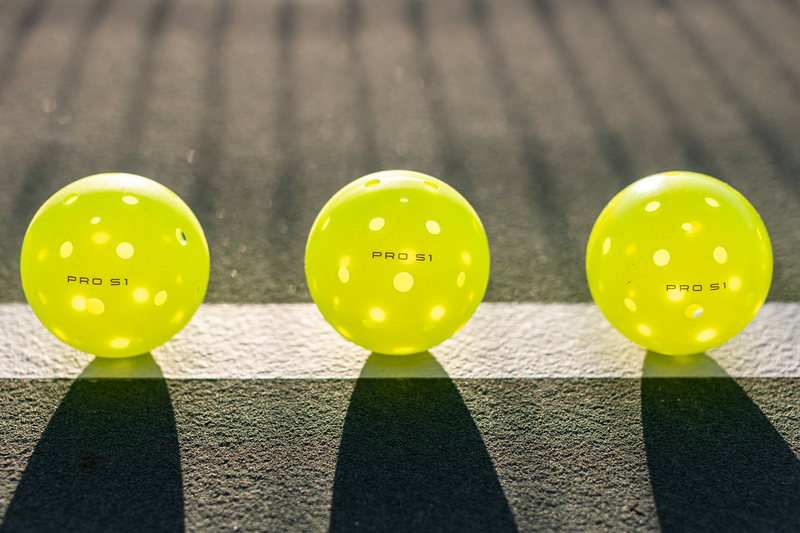When you are a beginner pickleball player, you have a lot of things to remember, and the different pickleball balls should be on that list. There are many differences between an indoor vs. outdoor pickleball ball — and many of these can affect your pickleball performance.
Differences between indoor vs. outdoor pickleball balls
Number of holes
- Indoor pickleballs usually have between 26 and 30 holes.
- Outdoor pickleball balls tend to have more holes than indoor balls — up to 40 holes.
Size of holes
- Indoor pickleballs generally have much larger hole diameters than outdoor pickleballs, because they do not have to deal with wind or other external factors.
- Because of the larger holes, indoor balls feel lighter and easier to control than outdoor pickleball balls.
Weight
- Indoor pickleballs tend to be lighter than outdoor pickleballs, largely due to the larger holes (and therefore less total surface area) than outdoor pickleball balls.
- Outdoor pickleball balls are built to withstand many outdoor conditions, including wind and outdoor courts.
Composition & texture of the ball
As you begin to play both inside and outside, you will find the hardness and texture of the pickleball ball will affect how you play. Some of the key differences in the hardness of indoor and outdoor pickleballs include:
- Outdoor pickleballs tend to be harder and thicker than indoor pickleball balls, due to the potentially extreme conditions of playing outside.
- Indoor pickleball balls tend to bounce higher than outdoor balls due to their lighter weight.
- Outdoor pickleball balls are more susceptible to cracking due to their higher weight and hardness and less elasticity.
- Indoor pickleballs do well on indoor pickleball courts but may easily crack when used outdoors.
USA Pickleball-approved pickleball balls
USA Pickleball is the overseeing authority of standard pickleball balls to be used for play. Here are their official rules for balls.
2.D.1 Construction
The ball should:
- Be made of a durable material molded with a smooth surface.
- Be free of texturing.
- Be one uniform color, except for identification markings.
- Have a slight ridge at the seam, as long as it does not significantly impact the ball’s flight characteristics.
2.D.2 Approval (for official tournaments only)
- The Tournament Director will choose the tournament ball.
- The ball selected for play in any USA Pickleball or Global Pickleball Federation (GPF)-sanctioned tournament must be named on the official list of approved balls posted on the USA Pickleball and GPF websites.
You can find those websites here:
2.D.3 Size
- The ball should be 2.87 inches to 2.97 inches in diameter.
- The maximum out-of-round diameter variance shall not be greater than +/-0.020 inch.
2.D.4 Weight
- The ball should weigh between 0.78 and 0.935 ounces.
2.D.5 Bounce
- The ball should have a bounce of 30 to 34 inches to the top of the ball when dropped from a height of 78 inches onto a granite surface plate that is a minimum of 12 inches x 12 inches x 4 inches.
- The test should be performed at an ambient temperature of 70 degrees Fahrenheit plus or minus 5 degrees Fahrenheit.
2.D.6 Compression
- The ball, undergoing a test performed in accordance with (IAW) ASTM F1888- 09, shall yield an average compression test result of <43 LBF.
- Each ball will be tested two (2) times, once with the load applied perpendicular to the ball seam and once with the load applied parallel to the ball seam.
- If there are no seams, then the ball will be tested once in a random location and the second location will be approximately 90 degrees from the first.
2.D.7 Hardness
- The ball hardness is no longer a compliance requirement.
- Here is the recommended hardness:
- The ball shall have a hardness of 40 to 50 on a Durometer D scale at an ambient temperature of 70 degrees F, plus or minus 5 degrees F.
2.D.8 Design
The ball:
- Should have 26 to 40 circular holes, with spacing of the holes and overall design of the ball conforming to flight characteristics.
- Should have a manufacturer’s or supplier’s name or logo printed or embossed on the surface, in addition to the “USA Pickleball Approved” seal or text treatment on the ball packaging in the case of balls intended for competition, or “USA Pickleball Approved” seal for non-competition applications.

